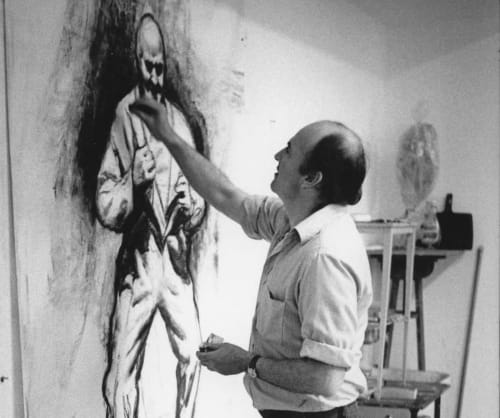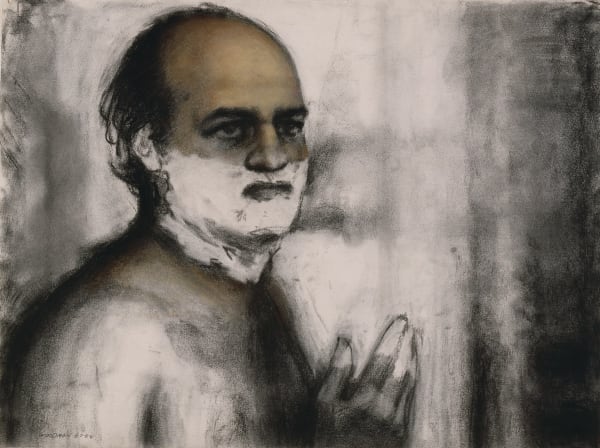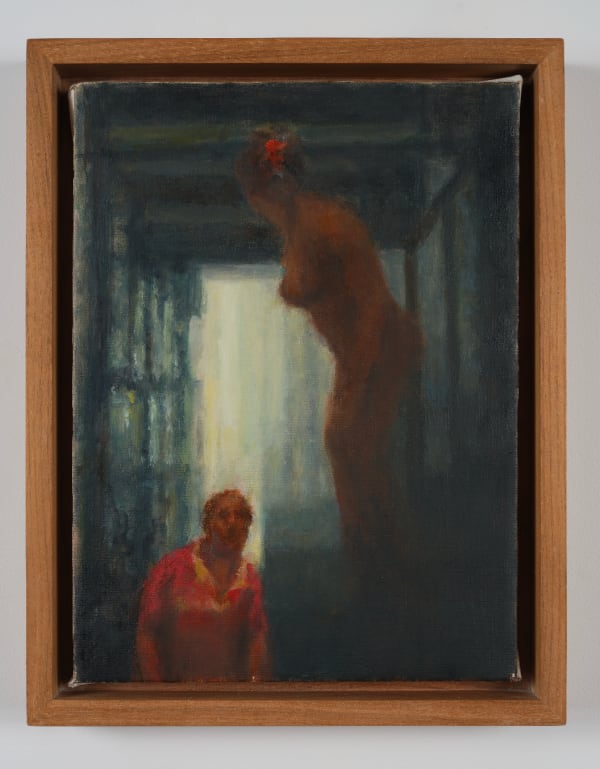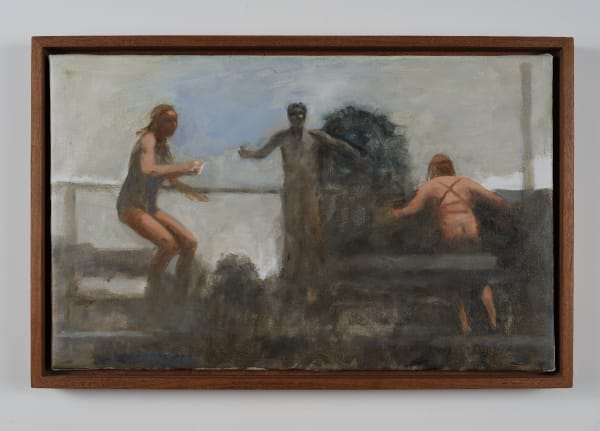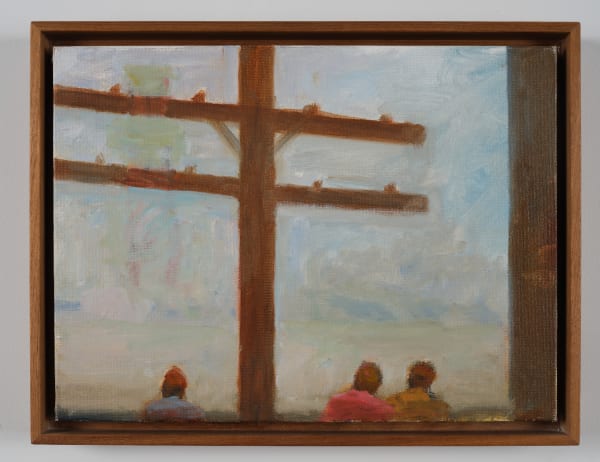Sidney Goodman 1936-2013
Goodman’s epic art was large. And contradictory. And contained multitudes. It spanned from serene to apocalyptic; from heroic to demonic; and from deeply empathetic to disturbingly violent.
One of the great pleasures in the arresting art of Sidney Goodman is the profound sense of emotional gravitas that is present. While art is not always an emotional enterprise, it is absolutely consumed with life and death matters for Goodman, as if he, upon a time, dedicated himself to the dangerous mantra of Eros-Thanatos, such as was represented in the famous Durer etching of the skeleton embracing the nude woman. This dramatic conjunction imbues Goodman’s art with an enthralling sense of immediacy and import.
Goodman’s work is highly theatrical, so that to apply the term “realism” is deceptive. Vivid yes, but real not at all is the imagery. Instead of an illusion of the everyday world, he suggests portentous events occurring in apparently mundane situations. This is a typical rendering of the traditional micro- to macrocosm transformation, in which a prosaic moment immediately speaks of larger issues. On the microcosmic level, Goodman’s images are often disturbing: no holds are barred and chaste decorum is anathema. We witness the human struggle to live, bear children, and watch as one’s time passes, even as a child’s time is now. If a background setting is shown, it is usually rather horrific. The urban scene, indeed modernity itself, macrocosmically speaking, is a thoroughly frightening place, full of detritus burning out of control. In this atmosphere, just holding on to another human being for dear life becomes essential to survival. Such situations are at once maudlin and life enhancing, with beneficence, even beatitude, the reward.
Much in Goodman’s work speaks of the Symbolist milieu—of dreams, visions, and bewilderment. The figures possess an inner vision, it might appear. Goya’s Sleep of Reason, wherein the world has lost its sensible bearings and is replaced by irrationality and brutality, offers one characterization of the Goodman sensibility. Night, of course. is the time when dreams, hallucinations, and imagination take flight, and darkness envelops many of Goodman’s images.
Freighted with much from art history beside Symbolism, Goodman’s imagery is permeated at times with Christian iconography, especially as depicted in Italian Baroque art where everyday reality has a spiritual dimension. Hence, there is none of the idealizing character of Renaissance art in Goodman’s work. But Baroque realism had less to do with a type of depiction that fools the eye than with the intense world of disturbing close ups—including, for instance, bloodied heads, animal hindquarters and age lines. Baroque stylization also influenced Goodman in that his art is founded on the dramatic organization of light and shadow contrasts. So thoroughly is his work an art of black and white, especially in drawing, that it explodes when pastel suddenly appears.
Figurative art has been such a third wheel in the modern tendency toward abstraction that at the turn of the millennium the Museum of Modern Art overview of the twentieth century, entitled People, Places, and Things, was something of a revelation. (Like every survey, it left out many important artists among them Sidney Goodman.) Even there, however, individuals were depicted in entirely formalist or neutral terms. Hence sections of the exhibition called “Composing the Figure” and “Unique Forms of Continuity in Space” showed artists employing the figure as if it were a still-life motif for pictorial manipulation; “Actors, Dancers, Bathers” dealt with figural spectacle; and “The Language of the Body” illustrated the figure being considered as a metaphor. Never in the course of the exhibition did the viewer encounter human emotions. Moreover, the human condition was submerged altogether. In his prescient book entitled Abstraction and Empathy (1906), the German aesthetician Wilhelm Worringer hypothesized that historical periods which are fundamentally uncomfortable with their institutions and lacking confidence in the human potential for effective, even heroic action produce abstract art, by which he meant styles showing figures either as unrealistically described, or distorted. While Worringer employed the Medieval Period and Egyptian art as his prototypes, he was, coincidentally, predicting the forthcoming age of Modernism.
But a new era has dawned: we live now in a period of ubiquitous figuration. In part—and surely the result of the prevailing usage of video, photography, and the general media overload in contemporary art and life—representational imagery of all types abound in every medium. Where, however, might we locate Goodman? He has none of the hip irony of artists consumed by popular culture and its plethora of imagery. Neither is his work about image manipulation, mechanical reproduction, sociological manipulation of stereotypes, or the deadpan investigation of kitsch. Neither is hyperrealism Goodman’s territory, although it is tempting to relate his work in a limited sense to Duane Hanson, the sculptural master of the human condition who specialized in a social realist cast of characters and was similarly ignored in the mainstream art world. Still, it is useful to join Goodman to Hanson, for behind them both is found Edward Hopper, with hymns to the poetry of the everyday. But Goodman is far more brutal than Hopper and Hanson, as well as bizarre.
A taste for Goodman’s work is reminiscent of the conflicted pleasure found in watching certain films by the German filmmaker Rainer Maria Fassbinder. In the American context, an artistic commitment to problematic subject matter, even if it is life enhancing, is like consuming unpleasant medicine, and is hence not terribly appealing. Nevertheless, the human condition is wondrous to behold and experience. Notwithstanding Worringer’s analysis, there is even a heroism in Goodman’s often tawdry environments. One recalls Willem de Kooning’s ebullient embrace of the vulgar, vulgarity being the shameless expression of the unfettered human being. Goodman’s figures have the authentic humanity and dignity so lacking in any of the figurative emanations found in that Museum of Modern Art survey and it is perhaps time to revel in and celebrate the soulful reality that he so evocatively depicts.
Mark Rosenthal
One of the most acclaimed, influential, and respected artists Philadelphia has produced.
A Philadelphia native, Goodman graduated from Philadelphia College of Art, now University of the Arts, in 1958. By the early 1960s, his boldly imaginative style of figurative painting had brought him national attention. When he was 27, Time magazine described him as "one of the most respected and sought-after of the new figure painters." By 30, he had appeared in an important exhibition of figure painting at the Museum of Modern Art and in two Whitney Museum annuals.
Yet this son of Russian Jewish immigrants was sufficiently levelheaded to realize that such fame might be fleeting. "I was new on the scene," he recalled during an interview in the mid-1990s. "Sometimes, I was almost a little embarrassed by the recognition because I knew that, today it might be me, but tomorrow it was going to be somebody else." He hit the big time during a period of sharp transition from abstract expressionism, which dominated the late 1940s and '50s; pop art, which glorified mundane objects, was just one of the creative currents that young artists were riding.
Some critics touted Mr. Goodman as one of the leaders of a "new realism," but they were a bit off the mark. He was committed to portraying the human figure, but he wasn't a describer or a storyteller. His paintings and drawings mixed observation with memory and imagination to produce images of powerful and sometimes disturbing emotional resonance. He could be intimate one minute, apocalyptic the next.
Mr. Goodman's art is existential and often Manichaean in spirit. It examines basic themes such as the human condition and elemental forces of nature. In his late pictures in particular, the images often are ambiguous, which makes it hard to assign definitive meanings. He had a knack for investing perfectly ordinary scenes or objects - a mirror reflection of him shaving, for instance - with exceptional visual and metaphoric force. On the occasion of a major Goodman exhibition at the Philadelphia Museum of Art in 1996, the late director Anne d'Harnoncourt recognized this when she remarked that "Sidney seems to all of us to be one of the very strongest figurative painters working in the United States today. I think he's a remarkable artist."
Mr. Goodman's early brush with national celebrity didn't tempt him to move to New York, which Philadelphia artists have always seen as art's Emerald City. He had shown his work there throughout his career, first at Terry Dintenfass Gallery and later at ACA Galleries. But he always found Philadelphia a more congenial place to live, for an artist who wasn't a millionaire.
Over the decades, his work ended up in many prestigious collections, including those of the Metropolitan Museum of Art, the Museum of Modern Art, the Whitney Museum, the Art Institute of Chicago, the Philadelphia Art Museum, and the Pennsylvania Academy of the Fine Arts.
Mr. Goodman began teaching at the Pennsylvania Academy in 1978; he retired in 2011. Before that, he had taught for 18 years at Philadelphia College of Art. Between the two schools, he helped to shape the careers of several generations of art students. He described teaching as "a rewarding experience. At PAFA, there is an atmosphere where I can practice what I preach." According to Jeffrey Carr, dean of the academy school, what Mr. Goodman preached had a strong undertone of art history that is also visible in his painting.
"This makes his work equally of this moment and profoundly informed by the past," Carr said.
Over the course of his career, Mr. Goodman received a number of formal honors, including a Guggenheim Foundation fellowship in 1962, the Hazlette Memorial Award for Excellence in the Arts (Painting) in 1986, and an honorary doctorate from Lyme Academy College of Art in 2006.
-
 Man Waiting, 1961Charcoal on paper25 5/8 x 19 1/8 inches
Man Waiting, 1961Charcoal on paper25 5/8 x 19 1/8 inches -
 Self Portrait, 1961Lithograph19 15/16 x 26 1/16 inches
Self Portrait, 1961Lithograph19 15/16 x 26 1/16 inches -
 Man with Box, 1965Charcoal and pastel on paper28 x 24 1/2 inches
Man with Box, 1965Charcoal and pastel on paper28 x 24 1/2 inches -
 Loungechair, 1968Charcoal on paper64 x 59 inches
Loungechair, 1968Charcoal on paper64 x 59 inches -
 Man in the Mirror, 1987-1988Charcoal and pastel on paper22 x 30 inches
Man in the Mirror, 1987-1988Charcoal and pastel on paper22 x 30 inches -
 Head With Red, 1988Charcoal and pastel on paper64 x 59 inches
Head With Red, 1988Charcoal and pastel on paper64 x 59 inches -
 Untitled, 2006Oil on canvas12 x 8 3/4 in
Untitled, 2006Oil on canvas12 x 8 3/4 in
30.5 x 22.2 cm -
 Trampoline, 2006Oil on canvas15 x 24 in
Trampoline, 2006Oil on canvas15 x 24 in
38.1 x 61 cm -
 Untitled, 2007Oil on canvas board9 x 12 in
Untitled, 2007Oil on canvas board9 x 12 in
22.9 x 30.5 cm

